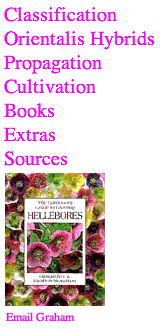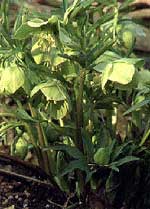
 |
Helleborus odorus Waldst. & Kit
|The easiest to grow and the most gardenworthy of the green flowered species, H. odorus is a tough, vigorous and early flowering plant which is rapidly becoming more popular and more widely available. Unfortunately it is confused both in gardens and in the wild with H. cyclophyllus, and it is true that the distinguishing characteristics are not as clear cut as we would like.
The main features which should distinguish H. odorus from H. cyclophyllus are these:
H. odorus has a more northerly distribution, but it overlaps with H. cyclophyllus at the south end of its range.
H. odorus has carpels which are not joined at the base whereas in H. cyclophyllus the carpels are joined at the base for a few millimetres.
H. odorus has overwintering leaves whereas those of H. cyclophyllus are deciduous.
Description
Normally a deciduous plant generally reaching from 14-22in (45-55cm) in height. The young leaves are usually slightly tinted copper or red-brown as they emerge from the soil and are usually noticeably covered with silvery down both on the backs of the leaflets and the leaf petiole. In most colonies in the wild there is a small percentage of plants whose young leaves are tinted with reddish-brown. The leaflets remain hairy underneath as the leaves mature but by summer only the faintest hint may be visible. The mature leaves on established plants are 13-16in (38-40cm) across usually with about five broad lobes, the outer ones divided to give 9-11. In Robin White's evergreen Corfu form there is a tendency for them to be held fairly upright and for the leaflets to arch out from the point of joining to create a fountain shape reminiscent of H. cyclophyllus.
Flowering occurs in late winter and early spring, sometimes starting earlier and finishing later than in most species. Each stem carries from three to twelve blooms with each flower 11/2in-21/2in (3.5-6cm) across and generally even in shape, although occasionally one petal may be slightly larger. They are made up of well-overlapping petals, each petal more or less the same shape generally making a flattish, rather open flower which faces outwards or nods only slightly.
The backs of the flowers are shimmering green, occasionally with a slight hint of copper, and inside are the green of unripe 'Golden Delicious' apples with translucent veins or they may be very dark green. It is not uncommon to find some plants, usually in groups in larger colonies, with flowers of a luminous yellow-green. In Robin White's form, the flowers are a very striking bright yellow green and some plants show an even stronger yellow colouring.
Scent varies according to the plant and the conditions on the day but is described by Elizabeth Strangman as 'Ribes, a little bit elder flowerish' or on accasions as 'cheap soap' and by myself as 'almost nothing, perhaps a fraction catty' on one occasion and 'quite sweet' on another.
This species is distinguished from the other closely related species by its especially leathery leaves which have broad, usually undivided leaflets and which are usually noticeably hairy underneath until fully mature. The flowers are relatively large, rarely less than 2in (5cm) in diameter, as they are in H. cyclophyllus, and so larger than those of other Balkan species. Of course, as with most species, the last flowers of the season tend to be relatively small.
The problems arise because H. odorus and H. cyclophyllus seem to grade into each other and possibly hybridise with each other in areas where they meet in the wild. In some populations of H. cyclophyllus the carpels are not joined at the base and in some populations of H. odorus there are plants with both joined and free carpels. Populations of reliably evergreen H. odorus have yet to be found in the Balkans; they are generally deciduous probably because the plants are covered with snow in winter. Confusion is magnified by the fact that hairy young foliage should be a feature of both species yet in some populations of H. odorus both hairless and hairy-leaved plants occur together.
Although the differences seem clear in theory, in practice they are not so obvious. The flower colour in both species is slightly variable, dark green through to apple green and sometimes a more luminous, yellow green.
These two species could be looked upon as contiguous, with a distribution running from Austria right down to Greece and Bulgaria with the southern forms known as H. cyclophyllus and the northern forms as H. odorus. However, in spite of these difficulties, Brian Mathew's classification remains the most helpful and so here we consider H. odorus as delineated by him.
Natural distribution and habitat
Helleborus odorus grows naturally in much of Yugoslavia, only in the coastal ranges where it is replaced by H. nultifidus and south where its is replaced by H. cyclophyllus does it seem to be absent. It is also found in northern Bulgaria, across the border in Romania and also further south on the island of Corfu although it is possible that the Corcyrean plant is better allocated to H. cyclophyllus.
In Slovenia near the Austrian border H. odorus grows on limy soils at the edges of pine woods along with Helleborus niger and Hepatica nobilis; Polygala chamaebuxus and Cyclamen purpurascens occur in the woods themselves. On grassy hillsides in north west Slovenia Gentiana verna and Crocus vernus var. albiflorus are early companions followed later by Iris pallida, Orchis tridentata and Pulsatilla pratensis var. nigricans.
In Bosnia to the north of Jajce, H. odorus grows out in the open on thin, rocky turf over limestone and also on the edges of woodland and scrub comprising oak, hornbeam, hawthorn and Cornus mas. Here it grows with bracken, in many locations this is the dominant plant, and also Cardamine bulbifera, Colchicum autumnale, Epimedium alpinum, Erythronium dens-canis, Galanthus nivalis, Geranium phaeum, Hepatica nobilis, Lathyrus vernus, Orchis morio, Polygonatum, Primula vulgaris, Pulmonaria, Symphytum tuberosum and various violas including V. odorata.
North of Travnik, on the high uplands to the east of the Vrbas river, this species grows in clearings in mixed woodland which includes Cornus mas, on the edges of pine woods and out in open meadows. Here bracken is again often dominant and other plants found include an Alchemilla, Anemone nemerosa and A. ranunculoides, Corydalis bulbosa, Crocus vernus in shades of mauve and purple some with lovely dark tips to the petals, a Doronicum, Euphorbia cyparissus, Galanthus nivalis, Isopyron thalictroides, a Polygala, Scilla bifolia, Symphytum tuberosum, and veratrums.
Alan Leslie and Joe Sharman have studied a number of populations of H. odorus in Yugoslavia. They found it in scrub, rough grass, in grassy grykes amongst limestone blocks and occasionally by streams. On the whole they concluded that the flowers became increasingly yellow as they travelled southwards. The slight red veining or general purplish tint to the flowers in some southerly populations is due to the influence of H. torquatus. Occasional plants had upward facing flowers.
West of Zagreb they found it in woodland dominated by broad leaved limes with Anemone nemerosa, Asarum europaeum, cardamines, Fragraria moschata, Lathyrus vernus and pulmonarias. Other colonies grew with Vinca minor in a variety of unusual shades including pale blue and blue with rich violet tubes to the flowers.
Cultivation
This is one of the easiest and most rewarding species to grow with its lovely bright green flowers and good, bold foliage. In humus-rich soil it quickly builds up into good clumps and while it is at its happiest in partial or thin shade, it will tolerate full sun if the soil is rich and deep. But like all hellebores it prefers shade from the fiercest midday sun in midsummer, certainly in southern gardens. It is less prone to frost damage than H. cyclophyllus.
In gardens
This is perhaps the best of the green flowered forms for gardens and although still usually only found in the gardens of specialists it is more widely grown than most. It has been used as a parent of yellow flowered strains by both Elizabeth Strangman and Helen Ballard. Robin White has listed a fine, very early flowering yellowish green form from Corfu for some years and Will McLewin and Jim Archibald have also distributed forms derived from wild collected seed.
Try planting with Cornus mas 'Aurea' and epimediums such as the evergreen E. x perralchicum 'Frohnleiten' which has yellow flowers above the leaves in spring. Cream primroses or the old white 'Harbinger' would also make good companions as would Hacquetia epipactis, ferns such as one of the forms of Polypodium australe, the creamy Cardamine enneaphyllos or C. kitaibelii and the many shades of Crocus tommasinianus. For a dash of bright blue try Scilla bifolia or x Chionoscilla allenii while bugles would also make a good association, especially the variegated Ajuga reptans 'Variegata' or for more of a contrast the metallic bronze 'Braunherz'.
There are no named cultivars of this species although E. B. Anderson grew a double flowered form in his garden at Lower Slaughter in the 1960s.
 |
|
|
|
|